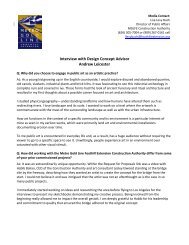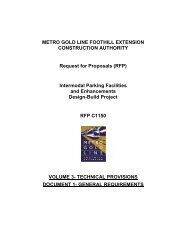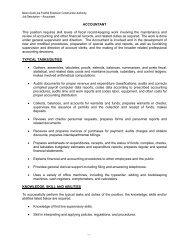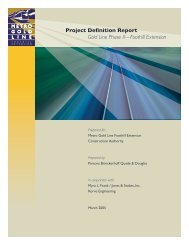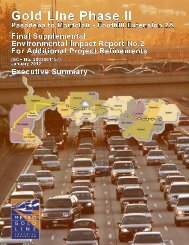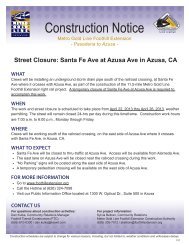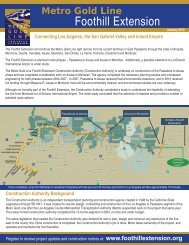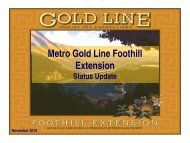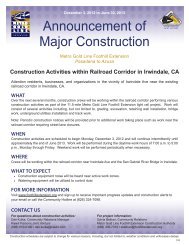Part 3 - Metro Gold Line Foothill Extension
Part 3 - Metro Gold Line Foothill Extension
Part 3 - Metro Gold Line Foothill Extension
Create successful ePaper yourself
Turn your PDF publications into a flip-book with our unique Google optimized e-Paper software.
Noise and Vibration Technical Report: <strong>Metro</strong> <strong>Gold</strong> <strong>Line</strong> <strong>Foothill</strong> <strong>Extension</strong>, Azusa to Montclair<br />
July 2012<br />
Page 107<br />
APPENDIX C. SUPPLEMENTAL MEASUREMENT DATA<br />
Force Density Level (FDL)<br />
The Force Density Level (FDL) used in this vibration analysis for LRT vibration predictions is based on<br />
measurements made in the historic Cornfields State Park along the operational Phase 1 of the <strong>Metro</strong> <strong>Gold</strong><br />
<strong>Line</strong> in 2008 for the <strong>Metro</strong> Expo Phase 1 vibration analysis. Previous FDL measurements were made in<br />
2001 and 2004. Following is a description of each of the FDL tests:<br />
1. 2005 DEIR FDL (2001 measurements): Force density measurements were taken by Harris,<br />
Miller, Miller, and Hanson (HMMH) along Phase I of the <strong>Gold</strong> <strong>Line</strong> with the Siemens (P2000)<br />
vehicle. Further information about the measurements is available in the DEIR.<br />
2. 2007 FEIR FDL (2004 measurements): The FDL used in the 2007 FEIR vibration analysis was<br />
the log average of the measured 2005 DEIR FDL and an FDL measured from a prototype<br />
Siemens (P2000) vehicle along the Bixby Knolls section of the Long Beach Blue <strong>Line</strong> in 2001.<br />
3. Cornfield FDL (2008 measurements): Force density measurements were taken by ATS<br />
Consulting in 2008 at the Los Angeles State Historic Park (The Cornfield) just north of the<br />
Chinatown Station of the <strong>Gold</strong> <strong>Line</strong> Phase 1. The test included measurements of the Siemens<br />
(P2000) vehicle and the Ansaldobreda (P2550) vehicle. The two vehicle types showed similar<br />
vibration levels and were combined into one FDL. This test was conducted as part of a detailed<br />
vibration analysis for the Expo Phase 1 line in Los Angeles. Additional vibration measurements<br />
of both vehicle types were made at the same location in October 2010 to confirm there have been<br />
no significant changes to vibration levels since the 2008 test.<br />
The FDLs from the three different measurements are shown in Figure 34. The FDL used in this analysis,<br />
the Cornfield FDL, is shown bolded in blue. The Cornfield FDL from the October 2008 test was used for<br />
the vibration predictions presented in this analysis for the following reasons:<br />
• The 2005 DEIR FDL has a peak in the 63 Hz 1/3 octave band that is not in the 2007 FEIR or<br />
Cornfield FDLs. Because subsequent measurements have not corroborated the peak, it is unlikely<br />
to be representative of what will occur on the <strong>Gold</strong> <strong>Line</strong> <strong>Foothill</strong> <strong>Extension</strong>.<br />
• The 2007 FEIR FDL was based on measurements on the Blue <strong>Line</strong>. The FDL for the <strong>Foothill</strong><br />
<strong>Extension</strong> Azusa to Montclair will most likely be more similar to measurements taken along the<br />
existing <strong>Gold</strong> <strong>Line</strong> track.<br />
• The Cornfield FDL is greater than or similar to the 2007 FEIR FDL across the entire frequency<br />
spectrum. Vibration predictions made using the Cornfield FDL are conservative and minimize the<br />
chance of underestimating the vibration.<br />
• The Cornfield FDL is the most up-to date data. The 2007 FEIR and 2005 DEIR data are based on<br />
measurements made more than five years ago.<br />
The Cornfield FDL is based on measurements of trains traveling at an average speed of 53 mph. If the<br />
trains are travelling significantly slower (when they are entering or exiting stations), the FDL will be<br />
much lower. To account for the difference in FDL due to lower speeds an adjustment of<br />
20*log(speed/53mph) was used. This is the adjustment recommended in the FTA Guidance Manual to<br />
account for fluctuations in the operating speed.



